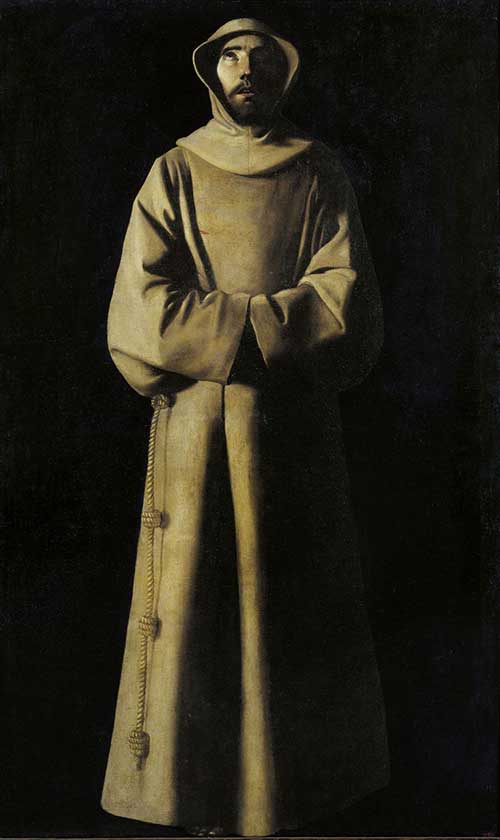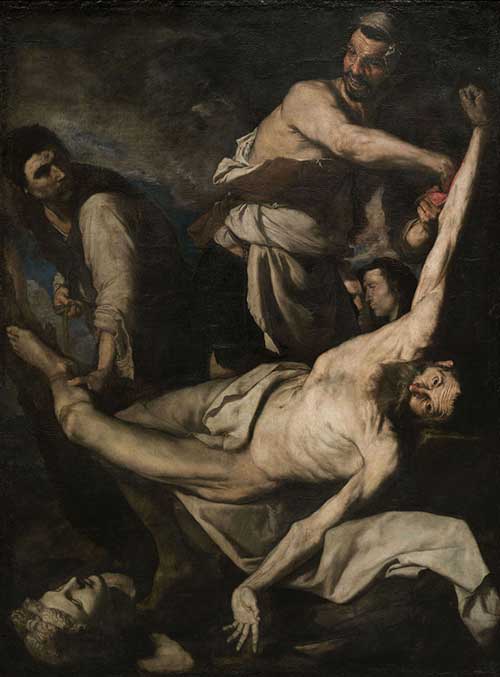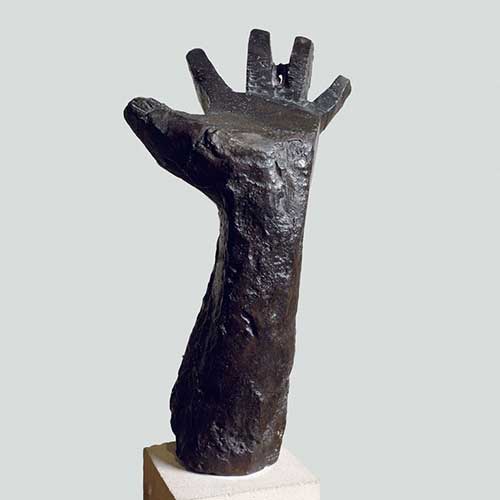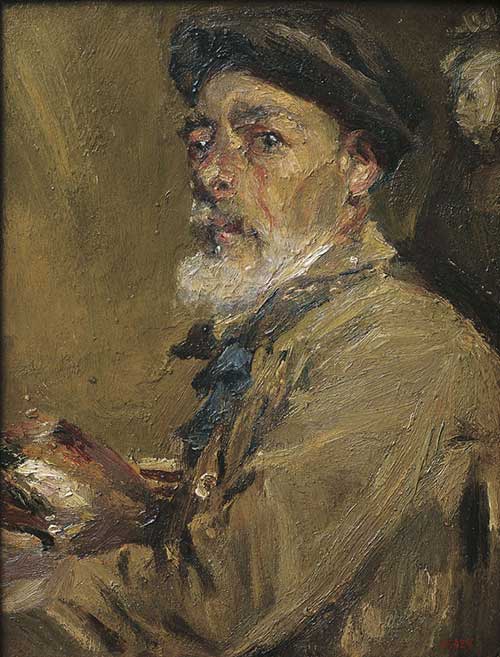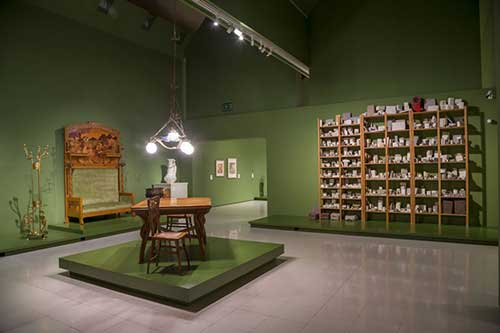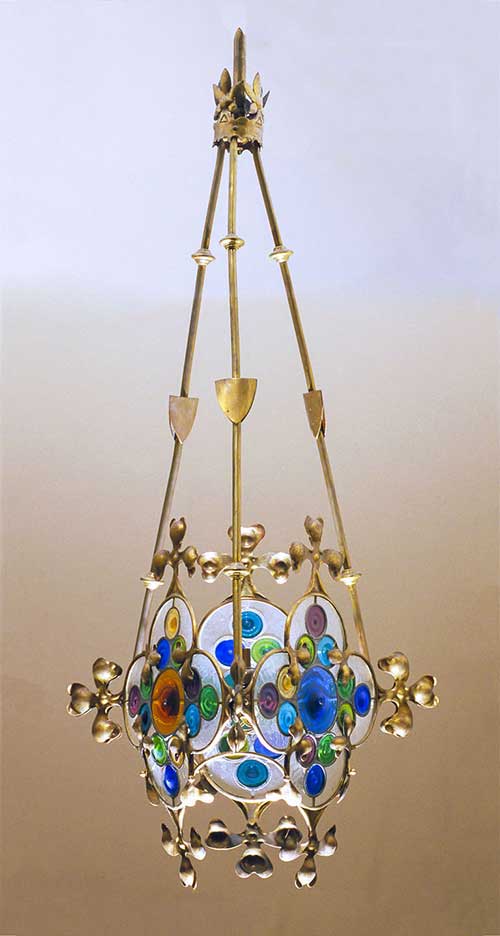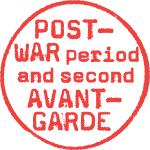
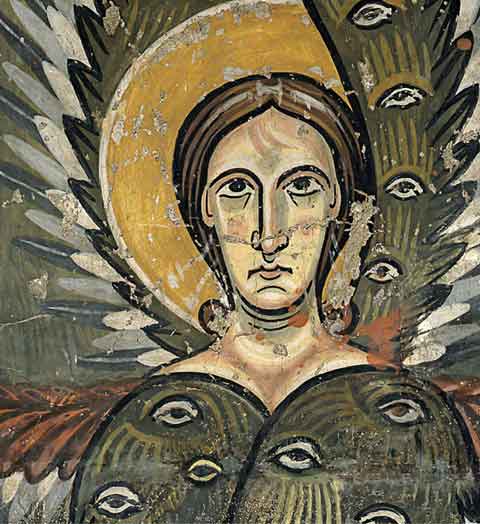
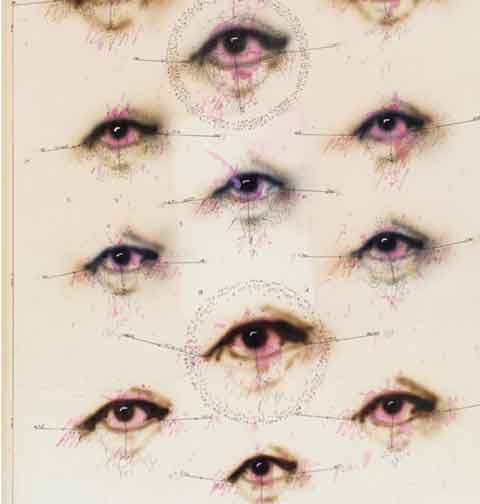
Intrusive Dialoges
Everything is the present
November 13, 2020 - November 7, 2021
This project has emerged from a collaboration between the Suñol Foundation and the Museu Nacional. Nineteen works from the second half of the 20th century that are part of the Suñol Soler collection are brought together under the framework of more than 1,000 years of history. Placed in different parts of the Museum, the works converse with each other about contrast and analogy, evoking diverse, new and open readings. Everything is the present. Everything is now. History and contemporaneity come together to explore today. Art offers us the possibility to ask questions and try out answers about our lives. Intrusive Dialogues breaks through temporal and cultural barriers to present an intense and personal – but why not collective too? – aesthetic experience.
It is also a museographic reflection project that breaks traditionally linear narratives of history and encourages a stimulating and productive promiscuity, an alternative to academic models, activating the questioning power of art. The public-private collaboration between the Museu Nacional and the Suñol Foundation is another step forward in building the country’s artistic heritage around postwar and second avant-garde art. We suggest you use the map that we have made available. Each piece is indicated in every room, and there are descriptive texts and audio available to guide you. But it is your visit and your participatory energy that we are most looking forward to. Welcome to the dialogues.
Listen to the audio
Ground Floor
Interactive map. Click on the rooms in red
Go to first floorMedieval - Romanesque ART rooms 1-16
Medieval - Gothic ART rooms 17-26
Renaissance and Baroque rooms 27–38
Sergi Aguilar. Dos-Tres núm. 1, 1978
+Circle of the Master of Pedret. Apse of Santa Maria d’Àneu, end of 11th century – beginning of 12th century
MYSTERY
Closed, impenetrable spaces that become vehicles for transcendence and receptacles of a truth revealed.

Sergi Aguilar. Dos-Tres núm. 1, 1978

Circle of the Master of Pedret. Apse of Santa Maria d’Àneu (detail), end of 11th century – beginning of 12th century
There are spaces that become repositories of mystery. Closed, hermetic containers (in the literal and figurative sense) can be vehicles for transcendence, to make contact with a revealed truth. The opacity of the symbolic saturation of the Romanesque as in the fascinating apse of Santa Maria d’Àneu and of the black and precise geometry of this piece by Sergi Aguilar (or the monolith in 2001: A Space Odyssey), paradoxically leads to enlightenment, to amazing knowledge that cannot be expressed in words. It is possible that the arrangement of Romanesque murals, with their linear borders, and the austerity of minimalist abstraction share with this piece an aspiration to the structure and rhythm that organises the world, in search of meaning.
Listen to the audio
Evru/Zush. Zeyemax, 1974
+Circle of the Master of Pedret. Apse of Santa Maria d’Àneu and Apse of El Burgal, end of 11th century – beginning of 12th century
KNOWLEDGE
The eye that contemplates and, with its hypnotic presence, pursues enlightenment.
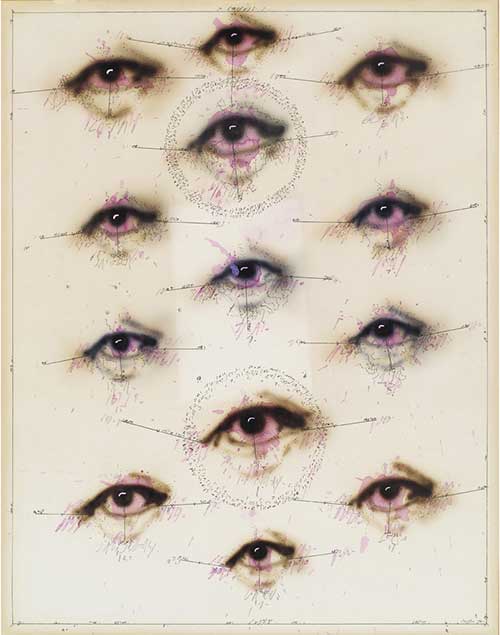
Evru/Zush. Zeyemax, 1974
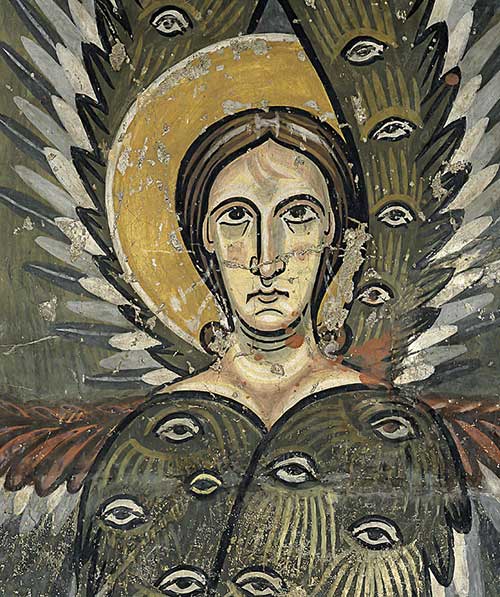
Circle of the Master of Pedret. Apse of Santa Maria d’Àneu (detail), end of 11th century – beginning of 12th century
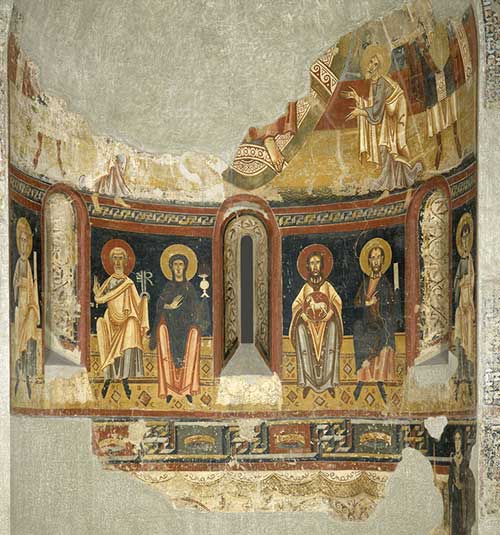
Circle of the Master of Pedret. Apse of El Burgal (detail), end of 11th century – beginning of 12th century
It is said that we live in an audiovisual culture. It is defined by the omnipresence of screens. It is interesting to note how in the 12th century, in a society in which the presence of images was not as common, the most popular symbol of visuality was not a projection (a ghost) but what looks and watches: the eye. The large, open, unblinking eyes repeated in an obsessive echo are one of the most striking aspects of these Romanesque works. If the screen shows and dazzles, the eye contemplates and reads. Evru/Zush is an esoteric artist, who seeks enlightenment. Like Francis Picabia, who had already noticed medieval eyes, or Buñuel and Dalí, who cut into the gelatinous interior of one, Evru/Zush delves into the symbolic fascination of the eye and into its hypnotic presence, which evokes the desire for knowledge.
Listen to the audio
José María Sicilia. Flor marco negro, 1987
+Anonymous. La Seu d’Urgell 1200 workshop. Tost baldachin, c. 1220
THE INVISIBLE
The abstraction that essentializes the natural world, which is not decorative but rather abysmal and primordial.

José María Sicilia. Flor marco negro, 1987
The monumental frontality of Sicilia’s work has the dignity of primitive medieval wall painting. The painting’s rough texture reminds us of the physical presence of fresco murals that have become worn by the passage of time. In the interior arrangement of Romanesque religious temples we also find that symmetry (with the slight asymmetries left by the human hand) defines the space for the liturgy, for sacred experiences. Sicilia arrives at abstraction from an informal and very earthly motif: the flower. Essentialising the natural world to the extreme leads to an abstraction that is no longer decorative but boundless, vital. We are reminded of Kazimir Malevich and his famous Square paintings (black, white or red), the equivalent of the cross or the divine face (of the icons).
Listen to the audio
Jaume Xifra. Chaise de salon d’art, 1974
+Anonymous. Altar frontal from Durro, mid-12th century
SUFFERING
Violent perversion, humanity’s timeless urge.

Jaume Xifra. Chaise de salon d’art, 1974
Few things are scarier today than pain. However, pain was very present in medieval times, when Christian art sometimes showed, with a graphic accuracy that today seems naïve to us (see Frontal d’altar de Durro) the different episodes of physical pain produced by torture and the executioners’ morbid imagination, that led martyrs to sacrifice and redemption. Xifra, a pioneer of conceptual art, has created a horrifying chair that suggests threatening torments rather than comfort. The barbed wire is a modern war invention, an aggressive obstacle that is used on a massive scale to cut off and block paths. A sinister thread of sharp needles that cut skin and flesh reminds us of the violent perversion that has always driven humanity.
Listen to the audio
Susana Solano. Colinas huecas núm. 15, 1985
+Various authors. Romanesque sculptures, 12th century – 13th century
ARCHITECTURES
Exuberant spaces compared to contained, severe architectonic echoes, all of them having different beauties.

Susana Solano. Colinas huecas núm. 15, 1985
Colinas huecas núm. 15 (Hollow hills no. 15) is a very contained and severe sculpture of architectural echoes. Halfway between a landscape and a piece of furniture, it evokes a transparent and enigmatic interior, like an empty reliquary or coffin. Its industrial finish reflects the material culture of the contemporary era where, beneath seductive appearances, a precise and fleshy structure of disturbing beauty is erected. Romanesque architecture, on the other hand, possessed a fragile and monumental dignity, while at the same time confronting the exuberance of the natural world. Spirituality and transcendence came through geometry (at the rhythm of arches and columns, for example) and symbolic narration (such as figurative capitals with biblical scenes and demonic presences). Monsters and beauty coexisted in the constructions of a humanity that protected itself from an often-threatening universe. Perhaps today we are not so different, with our fears and our need for comfort.
Listen to the audio
José Manuel Broto. A-3, 1984
+Anonymous. Panels from the tomb of the knight Sancho Sánchez Carrillo. Pleurants, c. 1295
EMOTIONS
The expression of intense feelings, dramatic landscapes and scenarios for passions.

José Manuel Broto. A-3, 1984
In addition to the centrality of Christian religious example and experience, the Gothic artist adds pathos (feeling), an intense emotional dimension. People vibrate ecstatically with mystical yearning or are shaken by loving affection or intimate suffering. Rediscovering the potential of expressionism from a postmodern perspective (that is, from a view that is both prospective and retrospective) Broto uses broad gestures, powerful brushstrokes, and furious drizzles as resources to create a dramatic landscape. He builds an enigmatic vision where we guess a ladder and, perhaps, a lighthouse that stands on a cliff. With ocher and copper tones, his work suggests a scene that can be interpreted as symbolic rather than real, a type of passionate allegory.
Listen to the audio
Eva Lootz. Sense títol, 1980
+Bonanat Zaortiga. Virgin of Mercy, 1430-1440
LIGHT AND SHADOW
Reality’s sublime dimension revealed two ways: the aesthetic of light and the horror vacui felt towards simplicity, shadow and emptiness.

Eva Lootz. Sense títol, 1980
Art from the medieval period is based on the mystique and the aesthetic of light. The Divine temples, images and objects, often modelled after goldsmithing, sparkle, gleam and dazzle with their kaleidoscopic richness. Horror vacui emerges from many works, especially religious altarpieces, which evoke the beauty and richness of the world created by God. Eva Lootz also creates a mystical space, to communicate with mystery, but she does so from opposite hypotheses that are based on simplicity by renouncing to figuration. Lootz plays with shadow and emptiness, probably not as opposing pulses of light and life, but rather as artists of the Japanese Zen tradition do, as a source of knowledge and serenity. The sublime dimension of reality could thus manifest itself in two ways: one explicit, descriptive and abundant, and the other implicit, silent and contained.
Listen to the audio
Antoni Tàpies. Butaca, 1987
+Lluís Dalmau. Virgin of the ‘Consellers’, 1443-1445
PRESENCE
Thrones, armchairs and chairs that ask us about our place in the world and our ambitions of power.

Antoni Tàpies. Butaca, 1987
Enthroned Virgin, the seated Virgin, the Virgin enthroned with the Christ Child: different iconographic typologies are repeated to dignify divine figures which welcome at their feet a humanity in adoration with the appropriate nobility. With powerful realism, Antoni Tàpies instead proposes an armchair, a bourgeois, luxurious and comfortable piece of furniture, which he leaves eerily empty. Contrary to the beautiful and often golden angularity of the Gothic chair, it is marked by worn age, scarified with roughly painted markings that highlight an absence. Its emptiness is a possible way to allude to human presence, which should question its place in the world and its claims to power.
Listen to the audio
Evru/Zush. Sabina eyeya, 1974
+Workshop of Francisco de Zurbarán. Christ Crucified, c. 1655
ATONEMENT
The body as a source of knowledge, antenna, sounding board, source of throbbing wisdom.

Evru/Zush. Sabina eyeya, 1974
The body is a territory of life and blood. The description baroque realism gives of the marks and wounds of saints and of humanity leads us to this discovery of carnality, of the transitory truth of organic life. The existence starts from physical, tactile and pulsing consciousness of our body. Evru/Zush offers us an inverted figure in a cross, the head replaced by an energetic spiral. The eyes seem to mark the cardinal points on an anatomical map, looking at us wondrously. The body is the source of knowledge of a universe that should be looked at, not from a common sense or the Euclidean space perspective, but by allowing the body to become an antenna, a resonance box, a source of pulsating wisdom.
Listen to the audio
Darío Villalba. Pies vendados, 1974
+Mateo Cerezo. Saint John Evangelist, c. 1665
HUMILITY
The human being who faces their own decadence and chooses the type of freedom and connections that they want in order to give value to their existence.

Darío Villalba. Pies vendados, 1974
The foot is an often-ignored limb. Lying at the opposite end of the head and intelligence, of the ideal, it is a symbol of what the philosopher Georges Bataille called “low materialism.” Conversely, for Joan Miró the foot was associated with the land and, in turn, with the sensual and vital authenticity of the land. In this image by Darío Villalba, the man whose feet are tied is prevented from moving. We immediately understand his lack of freedom. But the question arises of whether that limitation is desired or imposed, physical or metaphorical. Baroque naturalism also uses the human foot as a symbol, an expression of intimate humility. Figures like Saint Jerome evoke the nobility of the penitent sage who withdraws from the world. Addressing his own humility and decadence, man has to choose which kind of freedom and ties he wants to give value to his existence.
Listen to the audio
Eduardo Chillida. Rumor de límites IX, 1971
+Diego Velázquez. Saint Paul, c. 1619
MEDITATION
The contained severity invites us to turn our backs on frivolity and leads us to a place shot through with questions.
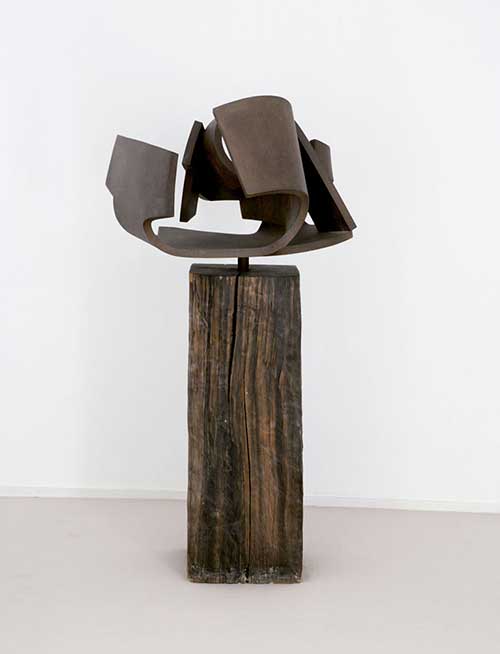
Eduardo Chillida. Rumor de límites IX, 1971
Recollection, solitude, meditation and inner confinement are states of the soul and spiritual needs that at certain points become essential, imperative. Baroque tenebrism made humanity emerge from the shadows to discover a transcendent illumination that elevates us, while being simultaneously anchored deeply in the body, in matter. Rumor de límites IX evokes a monastic austerity. The sheets of the steel plate, like a closing hand or a chorus that contains an inner silence, are cut out in the void, like the clothes of a saint or a philosopher. The contained severity invites us to renounce frivolity, it guides us to a space filled with questions.
Listen to the audio
Claudio Bravo. Pan tostado, 1974
+Luis Egidio Meléndez. Still Life with Apples, Grapes, Melons, Bread, Jug and Bottle, c. 1771
REALITY
Still lifes, never; rather, explosions of life that celebrate the mystery of things and, simultaneously, their sensuality and proximity.
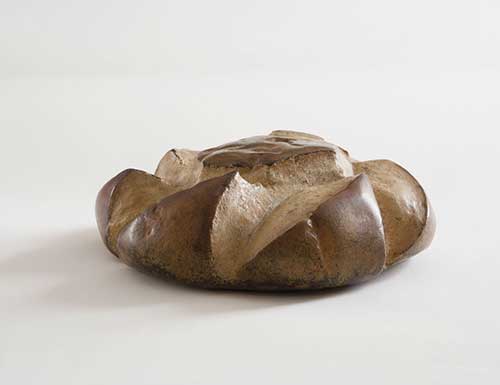
Claudio Bravo. Pan tostado, 1974
Bread is a staple food in history, a religious symbol, a shared memory of well-being and affection. When it is static, bread becomes monumental: “There are little things stock-still as a loaf of bread,” Salvador Dalí once wrote to Federico García-Lorca. Zurbarán looks at things with the same hallucinatory depth. Baroque still lifes are never still lifes, they are bursts of life, they simultaneously celebrate the mystery of things and their sensuality, their proximity. What has sometimes been called ‘hyperrealism’ — a loaded term, since reality is consistent enough to be hypertrophied — is interesting when it goes beyond surprise, the trompe-l’oeil. Thus, Claudio Bravo’s bread shows a humble and daily presence that, subject to our contemplation, becomes landscape, offerings, memories and banquets.
Listen to the audio
Lucio Fontana. Concetto spaziale. Pillola, 1967
+Juli González. Raised Right Hand / Raised Left Hand, c. 1942
REVOLUTIONS
Two eras and two opposing viewpoints under the same revolutionary spirit.
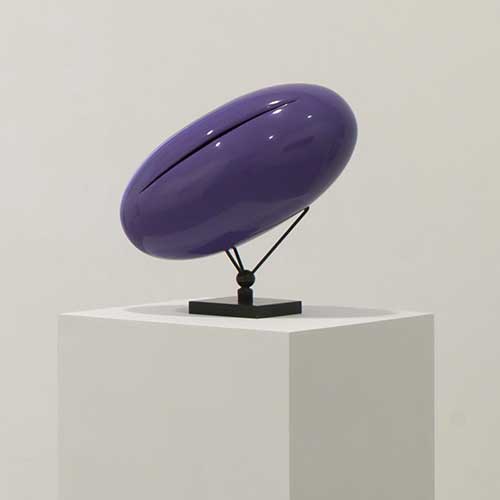
Lucio Fontana. Concetto spaziale. Pillola, 1967
Juli González, one of the fathers of modern sculpture, explored a highly radical path of schematic abstraction, but turned towards figuration again at the end of the 1930s, under the social and historical need to oppose the rise of fascism. Dense and tense, strong and mutilated, the hands are raised, like a cry, an expressive gesture that imposes itself in the void and dramatically challenges us, demanding justice and freedom. Lucio Fontana created what he called ‘spatial concepts’, works in two or three dimensions that, with a clean cut or a perforation, opened a wound, a door to another internal space. Concetto spaziale. Pillola uses the artist’s characteristic language of conciseness and total synthesis, but it also curiously hides a historical dimension that refers to the glittering era of Pop and the demand for the liberation of sexual behaviours. Two epochs and two perspectives confront each other, under the same revolutionary spirit.
Listen to the audio
Richard Avedon. Igor Stravinsky, 1975
+Ramon Casas. Self-portrait, 1882 | Francesc Gimeno. Self-portrait, c. 1925
IDENTITY
The face reveals an implacable truth: that of the passage of time.
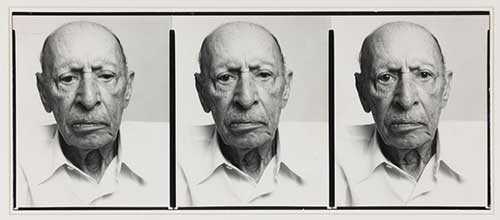
Richard Avedon. Igor Stravinsky, 1975
Our face is what distinguishes us, what makes us a person: our – Our – mask (etymologically ‘person’ comes from mask). In opposition to the selfie, the portrait with a capital ‘P’ reveals an implacable truth, that of the passage of time, our fragile youth or senility. Avedon, photographer of the glamour and sophisticated beauty of a wealthy society (and its dark side), portrays the historic composer Igor Stravinsky. The musician is shown as tired, used. In a tripartite sequence, he raises his gaze towards us and overwhelms us. Here, a Stravinsky at the end of his life meets a very young Picasso, as well as other characters, such as a Francesc Gimeno, with his marginal praise of decrepitude, and other artists with sometimes faked, sometimes authentic bohemian gestures.
Listen to the audio
Joan Hernández Pijuan. Díptic II / Paisatge amb horitzontal / Lápiz plomo 4h-h-b-2b-4b-6b, 1978
+Joaquim Mir. The Rock in the Pond, c. 1903
LANDSCAPES
The relationship of painting to what is real: from the orgiastic fiesta of colours to the greatest containment to make subtle auroras emerge.
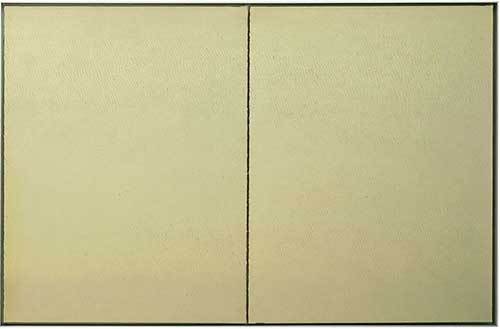
Joan Hernández Pijuan. Díptic II, 1978
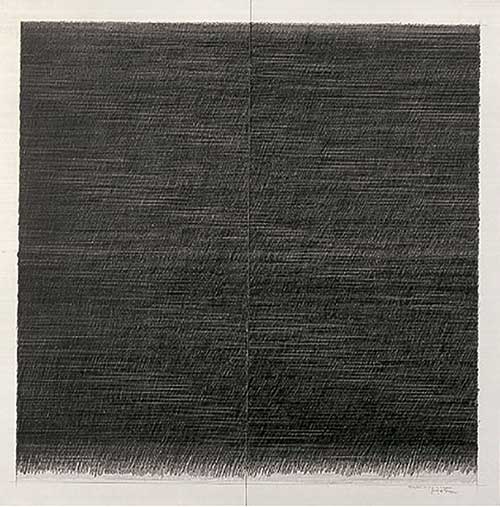
Joan Hernández Pijuan. Lápiz plomo 4h-h-b-2b-4b-6b, 1978
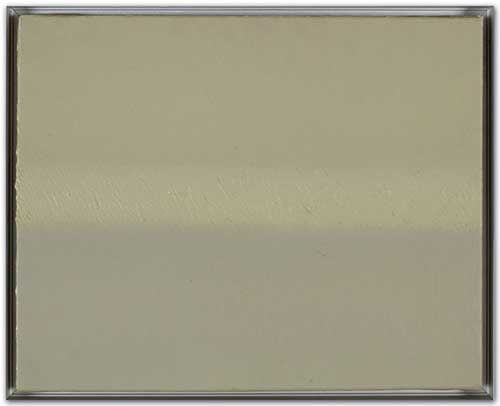
Joan Hernández Pijuan. Paisatge amb horitzontal, 1978
Beyond anecdotes and more or less domestic perspective that we have today, impressionism was a radical proposal: it painted light, that is, it painted colour. Although intuitive, it is a reflective painting that ultimately refers to itself, which is why it can be considered the beginning of modern art. From here, a new relationship between painting and reality becomes possible. Hernández Pijuan also addresses the light-colour-space-gesture relationship, but in a fully conscious manner, with a rigorous and analytical methodology, where limitation facilitates the emergence of an infinity of nuances. In contrast to the orgiastic party of explosions of colours that Joaquim Mir explores, Hernández Pijuan presents creations made from maximum containment, based on seriality (almost brushing repetition) causing subtle auroras to emerge that in this case turn the painting itself into a landscape.
Listen to the audio
Carmen Calvo. Estantería, 1990
+The Modernist House, c. 1900
ATTACHMENT
As if things (possessing them) protected us from chance events and fate.
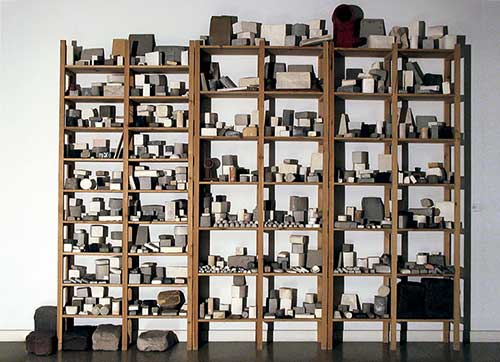
Carmen Calvo. Estantería, 1990
Possessing, collecting, ordering, displaying: the bourgeois interior has shaped our way of inhabiting space and our relationship with objects. Luxury and comfort are associated with equipment, with pieces more or less useful, more or less decorative, of a private or exhibitionist taste, that defines us and turns our homes into coveted havens loaded with images and volumes. Carmen Calvo’s Estantería refers to our need to accumulate, as if things (possessions) protect us from contingency and chance. Located in an indeterminate terrain between order and disorder, its greyness has a vertical presence that evokes the great buildings of modern cities but also the inglorious anonymity of attics and warehouses. It could stand as the background, the storage room of our glittering dreams of wealth, security, and consumption. It could also be a projection of our minds, furnished or loaded with data or experiences that make up a fragile personality, in need of support and tidiness.
Listen to the audio
Joan Brossa. Capitomba, 1986
+Josep Puig i Cadafalch. Hanging lamp with floral decoration, c. 1900
MONEY
Unmasking our relationship with gold: need, fascination and aversion.
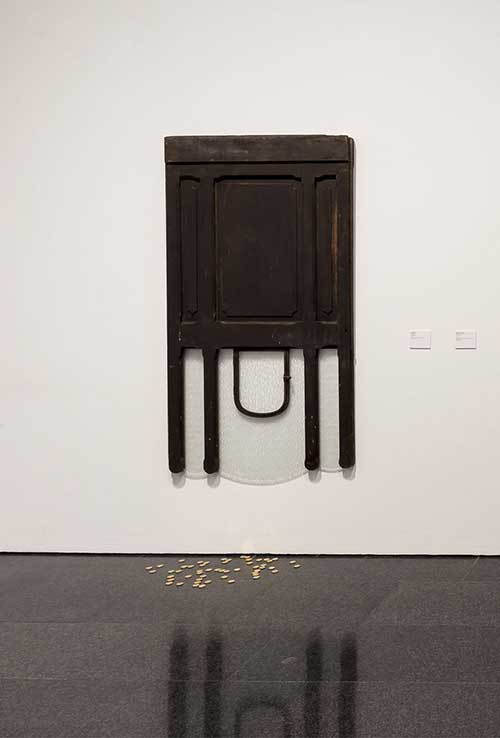
Joan Brossa. Capitomba, 1986
One of the avant-garde artist’s reasons for being is to act as a demystifier, as a revealer of the routines and established orders that configure our actions and desires. The exuberance and innovation of modernism created a fantastic and largely escapist universe with overflowing nature, oriental dreams and evanescent Nordic mists. The poet Joan Brossa presents a bank teller, turned upside-down, as if it had been pushed, from which gleaming coins – which are in reality innocent pieces of chocolate – fall out. Here humour is used as a resource to explain our relationship with need, fascination, and aversion to gold. With a simple gesture of appropriation, transforming our gaze of the everyday, Brossa suddenly reveals and unmasks the backdrops of our behaviour, of our history.
Listen to the audio










